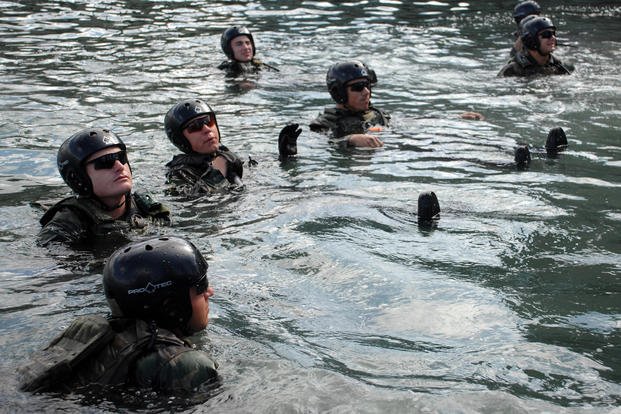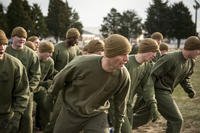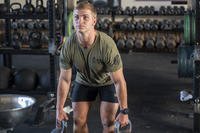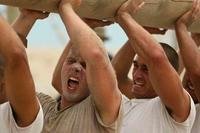Navy Special Warfare Combatant Crewmen (SWCC) -- highly trained people capable of high-risk missions around the globe -- are operators within the Naval Special Warfare community. They are skilled at driving some of the fastest boats in the military, shooting weapons, inserting from airplanes (airborne qualified) and performing combat medical care, to name a few of their capabilities.
Here is a question from a young man freshly inspired by a Navy-created video about the community.
Hey Stew. Have you seen the new SWCC -- Making an Operator recruiting video on YouTube? These have motivated me to want to join the Navy and become a Boat Operator. Any advice on how to start this training process? Thanks -- Future Boat Guy.
Yes! The hourlong video created by the military's All-Hands Magazine about SWCC training is a great inspirational and informational video about the fairly new program. The video is broken into three sections Episode 1 - SWCC --Making an Operator, Episode 2 and Episode 3.
Each takes the viewer through the grueling process required to graduate from the program and gain access to the community. But, as you wisely pointed out, there is a process of training and evolution of development that is required, from being inspired to being fully prepared for that training program.
Give yourself enough time and training to follow this specific journey:
1. Inspiration
It's great to find something that inspires you. This near-euphoric feeling ignites a passion and energy that is hard to duplicate. If you are lucky, you will have one or two life-changing significant events during your lifetime.
But the benefits of inspiration only last so long.
2. Motivation
You must use this external motivation to become self-motivated. While you are still excited and motivated, build good habits of training. Start to remove bad habits while you create habits of training hard and mentally preparing yourself each day. But you will not be motivated every day of this journey; this has to evolve further.
3. Discipline
Motivation and habit-building have to evolve into discipline. How do you know if you have the discipline to continue on this path? One day, you will wake up and not feel like getting out of bed and training. But you decide to train anyway. You may not feel like getting wet, but you jump into the pool for swim training anyway.
These moments take your motivation and turn it into discipline. Now, you can rely on your discipline "even when you don't feel like it." One day, some of your best workouts will come from those initial moments of not feeling it -- but you get it done anyway.
4. Mental Toughness
As you can see from the videos, you need to have mental toughness as well. You will build mental toughness by getting comfortable with being uncomfortable. Training when you don't feel like it. Getting wet when you feel like staying dry. Continuing to run when you feel like walking.
Each of these have a way of adding a scoop of mental toughness to your backpack that you can pull from your developed traits of working hard to achieve this originally inspired goal of being a "Boat Guy."
We all had something that inspired us to serve in this way. Maybe it was the hometown hero who earned the Medal of Honor or the original "Top Gun" in the 1980s? Regardless, the inspirational moment resonated with you and drove you to become a better person and overall performer so you could reach your ultimate goal.
Some final advice: Wait to talk to a recruiter until you are crushing the Navy Physical Screening Test (PST), consisting of a 500-yard swim, push-ups, sit-ups, pull-ups and 1.5-mile run). If you cannot ace this test with ease, that will be the first hurdle you will face.
Ensure that recruiters take you seriously by showing up on Day 1 of the PST and crushing the advanced standards. See related articles to help you with this first step, then build your body to prepare you to get through SWCC training. Practice treading, load-bearing, sand running, swimming with fins and much more.
Build Strength -- Maintain cardio for PST scores
Learn the Phases of Tactical Fitness: Phase 1 -- Get TO the Training, and Phase 2 Get THROUGH the training.
This process will take time and depends on your current fitness level, athletic history and reaching the standards to get accepted into the training, Then become fully prepared to endure the special ops selection training. Be patient and do not rush the process.
Stew Smith is a former Navy SEAL and fitness author certified as a Strength and Conditioning Specialist (CSCS) with the National Strength and Conditioning Association. Visit his Fitness eBook store if you're looking to start a workout program to create a healthy lifestyle. Send your fitness questions to stew@stewsmith.com.
Want to Learn More About Military Life?
Whether you're thinking of joining the military, looking for fitness and basic training tips, or keeping up with military life and benefits, Military.com has you covered. Subscribe to Military.com to have military news, updates and resources delivered directly to your inbox.






















